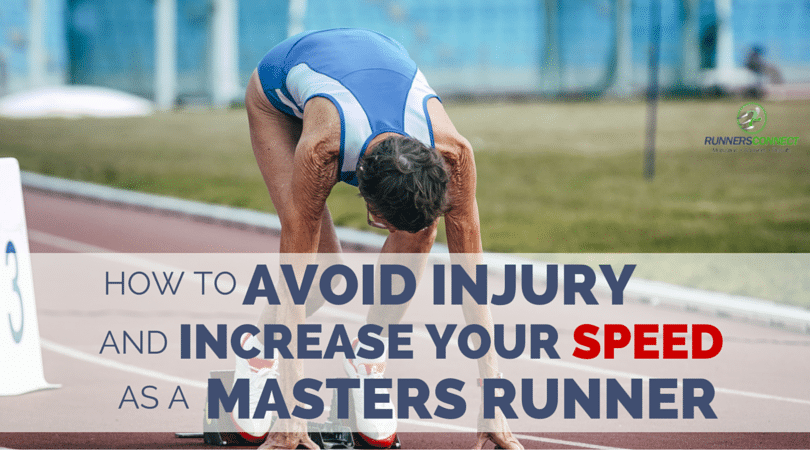Masters running did not always exist.
There was no running advice for older runners, and running over 50 was considered rare. Many thought that running was harmful for middle-aged people.
But slowly, more older runners training for races began to show up. The masters division of running was born, and now you can use age graded calculators to find out exactly where you fit, especially if you continue running after age 60 and beyond.
We know age and running speed are negatively correlated, and we will naturally lose some speed as we get older, but masters running training definitely is not all bad news.
There is still not a great deal of information on older runners training available, but we are trying to change that.
We already gave you advice on how to transition onto the track if you are interested in participating in the masters track championships, and today, we would like to take that one step further to give you a masters track and field sprint training guide to help older runners increase speed.

But first, can masters runners do speed work without ending up injured?
Yes!
But with some modifications in mind.
Masters runners looking for inspiration can find it easily in the forms of Deena Kastor, Meb Keflizighi, Pete Magill and others.
All are excellent examples of the over-40 crowd still keeping speed in their legs and on the roads. Clearly, to compete at their levels, speed work is involved.
For mere mortals, however, is speed work a recipe for injury once you’ve become a masters runner?
Is it possible to stay speedy AND healthy at this age? What about as you leave your 40s? Should you stay away from speed once running in your 50s, 60s, and 70s?
The answer—one that will make most older runners smile—is yes, you can avoid injuries and keep your speed.
But not without a few tweaks to how you go about it.
Here’s the deal:
The reality is that as we age, our muscles lose elasticity, making them more susceptible to aches, pains and injuries.
Speed work, probably more than any other aspect of running, can put a strain on those less elastic muscles and tendons.
So while speed work and chasing time goals is still a reality, it does require some adjusting.
British running coach Bruce Tulloh, former Olympian and European champion, says that many of the same rules that apply to sub-masters runners apply to older runners when it comes to speed.
“Masters runners just need to take more precautions,” he says. “This involves several steps.”
To that end, Tulloh, who is still running three to four times per week at the age of 80, and is author of Running After 40, 50, 60, 70…” offers up some of his tips, along with ours:
Warm Up Better
Warming up is something every runner needs to do before a speed session.
It gets the blood flowing to the muscles and primes the aerobic system to take on the hard work that is to come.
For masters runners, it is doubly important. Tulloh recommends masters runners consider the following routine:
- 15 minutes of easy running
- 5 minutes of stretching
- 5 minutes of 60-second strides
The easy running should be just that—something far below your race paces and truly done without any sort of pace guidance.
Just go by feel and make sure it is nice and easy.
The five minutes of stretching should be dynamic in nature.
As to the strides, perform those at about 90 percent of max and bring your heart rate back down to easy aerobic levels before starting your next repeat.
NOW you are ready to tackle the track.
Minimize the number of high-quality sessions you run each week
This is something I have taken to heart in my last decade.
I used to regularly run quality sessions twice per week, plus my long run.
These days, that’s only once per week. But some masters can handle more. The important thing is that it is less than what you used to handle.
Tulloh’s basic guidelines for masters runners:
- If over 50, no more than two high-quality sessions per week
- If over 60, no more than one such session
Keep in mind that racing counts, too, so if you are in recovery after a race, you are already one session in and need to adjust your training accordingly.
Do strides
While I have cut back on the number of speed sessions I run each week, I have increased the the frequency of when I do strides.
Tulloh is a big fan of strides for masters runners.
“Many injuries can be avoided by doing six or so fast strides at the end of easy runs a couple of times per week,” he explains.
To do strides properly, find a flat stretch of road.
Once you finish your easy run and your heart rate has come down, power through about a half dozen 20-second strides.
These should reach a high effort level—around 90 percent of max heart rate—and should be broken up by walking or lightly jogging back to the starting point.
Strides like these, says Tulloh, help keep leg turnover rates high and muscles more flexible.
Increase recovery between efforts
When you are performing speed work, keep in mind that as a masters, recovery is key.
Where you might have taken a 200 recovery between mile repeats, for example, consider lengthening the easy running to 400, and so on.
This will allow for adequate recovery before diving into the next tough interval.
Forget your past intervals
This is important:
While keeping speed in your routine is important as a masters runner, doing your repeats on numbers you did 10 years ago isn’t going to do you any favors.
Allow yourself the grace of some slowing down while still challenging yourself.
If your ego can’t take what the watch tells you, run without one.
My friends and I have given up running for any particular pace. Instead, we run by feel, even on the track.
We still go hard and we still get benefits. We just can’t compare our 50-year old selves to our 40-year old selves.
Race yourself fit
Another approach that is popular among masters runners is using races as speedwork.
Local 5ks—often a dime a dozen—are a perfect way to do this.
Run easy for most of the week, including strides of course, and then tackle a race on the weekend.
It’s not only a great way to keep speed in your legs, but it adds a social aspect, too.
Keep it mostly local and it won’t take much time out of your busy weekend, either, especially if you are considering a 5k or 10k distance.
Cool down—all the way down
When you are time pressed with work or family obligations, the first thing to go is often the cool down. Tulloh says this is a mistake.
“I suggest at least a mile of easy running after speed,” he says.
My friends and I have a two-mile(ish) loop that we use when running track for both our warm up and our cool down.
Easy is the word for this part of the run and our legs are much happier post-cool down than before, trust me!
What’s the bottom line?
The good news, then, is that speed work doesn’t have to be a thing of the past if you are beyond 40.
It does, however, have to be treated with care.
But Tulloh says, if done right, speed can be a masters’ best friend:
“As Peter Coe once said: ‘The athlete should never be too far away from speed.’”







One Response
Amanda: LONG SLOW RUN PACE??????????
I am a 55 yr m who ran his first 5k 3 years ago in May: Year 1 39 minutes, yr 2 36+ min, last may 33 min.
It is winter; I am doing cardio on the treadmill 3-4 times per week – typically I run 25 min at 6.1 mph with 1% incline, then I walk 15 min at 4 mph with 4 to 6% incline.
At 6.1 mph, I cannot talk without gasping.
I want to add a long slow run once per week starting at 3 miles and increasing a half mile per week for three weeks with a fall back on the 4th week and repeat .
I have seen the heart rate formula and the speed formula — they give me long slow run pace of 14.7 min/mile or 77 bpm. This is too slow; it is walking. My resting heart rate is 60 and I used 11 min miles to do the pace formula. Even 75% of a ten minute mile is really slow
To do a long slow run can I just slow down a little? Maybe set the treadmill at 5.7 instead of 6.1?